The Off the Beaten Track Adventure From Bali to Komodo Island
This itinerary from Bali to Komodo island is made of unforgettable adventures and discoveries: ideal for holidays with family or friends!
Between its pink sand beaches, its hikes on green hills and volcanoes, and its incredible diving spots, Komodo National Park is a real treasure for travelers in search of magnificent landscapes and unforgettable adventures. Not to mention the famous Komodo dragons, to see absolutely once in your life! Komodo National Park includes the three large islands of Komodo, Rinca and Radar as well as many other small islets that are full of breathtaking landscapes, stunning seabed and animals that you will not see anywhere else. Follow this guide to organize a successful stay in Komodo!
In 1991, the park was included in the list of World Heritage and Biosphere Reserve by UNESCO since 1977.
See Komodo, the world’s largest lizard, in their natural habitat with this tour from Bali. You’ll fly to Flores Island and cruise to Rinca Island, part of Komodo National Park, where you’ll have the chance to see the gargantuan creatures up close. This package includes two nights of accommodation, breakfast and lunch over two days, and the services of a local guide.
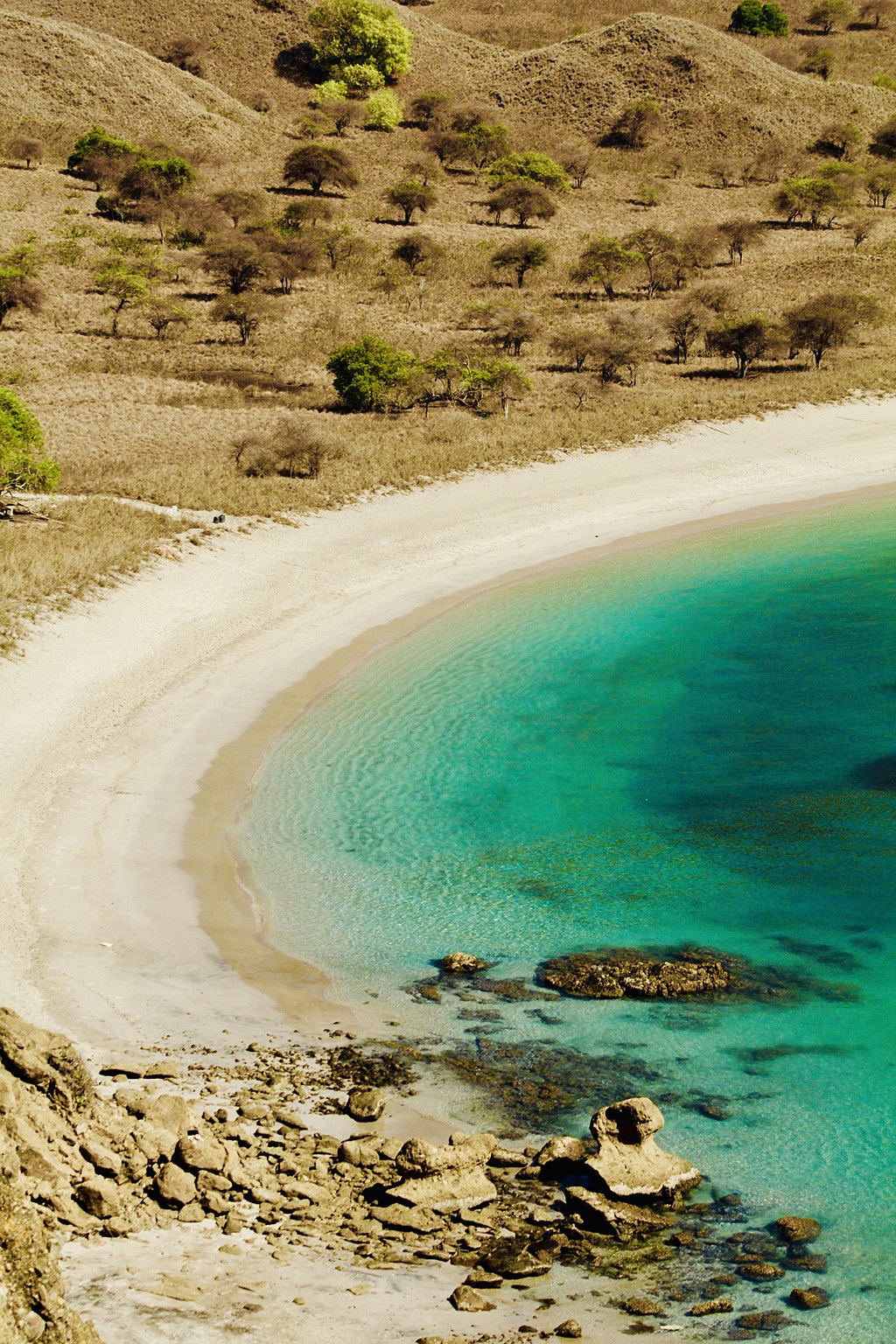
The Komodo island doesn’t get much rain, creating a unique and somewhat rugged land that stands out against the vibrant green ocean waters. Andre Aquino, CC BY-SA 4.0, via Wikimedia Commons
Highlights
Most people come to Komodo National Park to see the biggest lizard in the world, the Komodo dragon. These dragons live on specific islands like Komodo, Rinca, Gili Motang, Gili Dasami, and Flores.
The largest group of Komodo dragons, about 2,000 of them, can be found on Flores island. The next biggest population, around 1,700 dragons, lives on Komodo island. If you get the chance to see a Komodo dragon hunting and catching its food, you’ll see just how strong and important they are.
How to go from Bali to Komodo Island and what are the prices?
To travel from Bali to Komodo Island, you can take a flight from Ngurah Rai International Airport (DPS) in Bali to Komodo Airport (LBJ) in Labuan Bajo, Flores. The flight duration is approximately 1 to 1.5 hours. Once you arrive in Labuan Bajo, you can take a boat or a ferry to Komodo Island.
1. Go Labuan Bajo? (starting point for cruises to visit the Komodo Islands)
Labuan Bajo is the starting point for cruises to visit the Komodo Islands. There are two ways to get there: by plane, it’s fast, comfortable. Or by boat, but it is longer and the crossing can be dangerous.
By airplane
A) From Bali to Komodo Island by plane, then ferry
Duration: 1 hour 20 minutes. Cost: fares start at IDR 469,000 (US$31.50)
From Bali Airport (DPS) to Labuan Bajo (LBJ) Airport, it takes 1h 10mn.
From Labuan Bajo ferry terminal to Komodo National Park it takes (2h 30min by ferry once a day).
What airline companies run services from Bali and Komodo Island?
- Lion Air
- NAM Air
- Batik Air (Parent organization: Lion Air)
- Garuda Indonesia
- Citilink Indonesia
- Air Asia
If you are boarding an international flight, the island is accessible via Jakarta on the island of Java, or via Denpasar in Bali (DPS airport). From these 2 cities, you can then take a domestic flight to Labuan Bajo in Flores, this is the airport and the departure city for tours to visit the Komodo Islands. A flight from Jakarta to Labuan Bajo will take about 2.5 hours while a flight from Bali to Labuan Bajo only takes an hour.
B) Flights from Lombok to Labuan Bajo
Duration: 1 hour 15 minutes
Cost: fares start at IDR 703,000 (US$47.50)
For some years there has also been a daily flight from Lombok to Labuan Bajo, operated by Lion Air/Wings Air.
C) Flights from Jakarta to Labuan Bajo
Duration: 2 hours 15 minutes
Cost: fares start at IDR 1,200,000 ($81)
Direct flights from Jakarta to Labuan Bajo are operated by Lion Air and Citilink. The duration of the trip is around 2h15 and fares start from IDR 1,200,000 ($81).
D) Flights from Surabaya to Labuan Bajo
Duration: 1h30.
Cost: fares start at IDR 630,000 ($42.50).
The flight between Surabaya and Labuan Bajo only takes 1.5 hours. Batik Air operates a daily direct flight that departs at 11:10 am from Juanda de Surabaya airport.
Notes: flight fares can vary depending on the airline, time of booking, and class.
By boat (ferry)
Less comfortable, long but more economical option: you can also get to Labuan Bajo by boat from Bali or Lombok and then by bus. But this alternative is not recommended because of the very fluctuating schedules, the length of the journey (36 hours minimum) and above all the discomfort and insecurity of the ferry.
The slow ferry departs from Lombok from Lembar port to Labuan Bajo, the crossing lasts 27 hours, departure at 5 p.m. and arrival at 8 p.m. the next day. The price is IDR 236,000 (around USD 15 or AUD 23), reservation possible on the PELNI website.
Another alternative if you have more time is to take a multi-day boat trip from Lombok, an island just east of Bali. But this cruise is long with uncomfortable boats. On this route the sea can be rough and accidents have been reported in the past.
2. How to get around in Flores?
You can choose to take a day trip which will allow you to visit the islands of Rinca and Padar in 1 day with a departure in the morning and a return in the late afternoon.
If you want to visit more, as well as other more remote islands then you will need to take a 2 to 4 day cruise depending on what you want to visit. You will therefore live aboard a boat for several days and sail from island to island, alternating visits to islands, beaches, snorkeling spots, hiking…
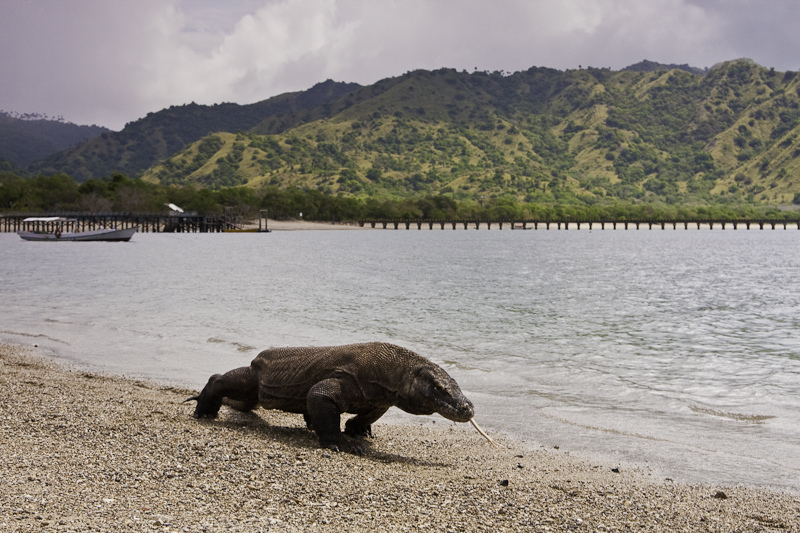
Komodo dragon at Komodo National Park. Adhi Rachdian from Indonesia, CC BY 2.0, via Wikimedia Commons
3. Prices for entering Komodo National Park, including entrance fees and activities
Here are the estimated general entrance fees for Komodo National Park, as well as the activity fees for both Indonesian and foreign visitors (valid from Monday to Sunday):
The general entrance fee to Komodo National Park is approximately:
- For foreign visitors:
- Monday – Saturday: IDR 150 000 (USD 9.55) / day / person
- Sunday and national holidays IDR 225 000 (USD14.32) / day / person
- For Indonesian visitors:
- Monday – Saturday: IDR 5 000 (USD 0.32) / day / person
- Sunday and national holidays IDR 7500 (USD 0.48) / day / person
The activity fees for Komodo National Park for Indonesian and foreign visitors (Monday-Sunday) are approximately:
- Trekking: IDR 5000 (USD 0.32)
- Wildlife viewing: IDR 10 000 (USD 064)
- Snorkeling: IDR 15 000 (USD 0.96)
- Diving: IDR 25 000 (USD 1.60)
- Sport Fishing: IDR 25 000 (USD 1.60)
- Photography: IDR 250 000 (USD 16)
The total fee is determined by adding up all the charges for the activities on your trip. For instance, a standard boat trip usually covers the main fee, hiking, seeing wildlife, snorkeling, and taking pictures.
Source: Official Instagram account of the Komodo National Park (in Indonesian Language)
The Komodo entrance fee covers a lot of amazing experiences:
Guide
Certified local guides will be with you, sharing their deep knowledge of the park’s plants, animals, and history. They’ll make sure you have an educational and enriching journey.
Meeting the Dragons
You’ll get to see the incredible Komodo Dragons, the world’s largest lizards, in their natural home. These impressive creatures, with their ancient look, big size, venom, and unique behavior, will leave you in awe and give you an unforgettable memory.
Beautiful Hiking Paths
Explore the stunning landscapes of Komodo National Park through its well-maintained hiking trails. Every step you take reveals a new wonder waiting to be found, from lovely hillsides to breathtaking views.
Snorkeling and Diving Fun
Jump into the colorful underwater world around the Komodo Islands. You’ll come across a dazzling array of vibrant coral reefs filled with sea life. Whether you’re snorkeling or diving, you’ll be amazed by this underwater paradise.
The reasons for this increase initiated by the government!
The Indonesian government explains this pricing decision with a report from the Ministry of Environment and Forests concluding that Komodo National Park would not be able to welcome more than 219,000 annual visitors.
It is true that since its inclusion on the UNESCO World Heritage List in 1991 and since it was named one of the 7 natural wonders of the world in 2011, Komodo Island has been stormed by tourists of the whole world.
🦎 Visiting Komodo National Park? Read This First
Before you explore the stunning Komodo National Park, make sure you follow the park’s rules and guidelines. These are designed to protect the wildlife, natural habitats, and everyone’s safety.
✅ Download the Siora App (Mandatory)
All visitors must download the Siora app to obtain the entrance permit and stay updated on park regulations.
Is it dangerous to visit Komodo?
As for Komodo… that’s another story! There have been accidents before and they are potentially dangerous wild animals. Indeed, their saliva contains many bacterias and their bite can be fatal. In addition, they measure up to three meters long, weigh 150kg (330 lbs) and can run at more than 20 km/h (around 12 mp/h). Generally it does not make you want to rub it too much.
However, if you listen carefully to the instructions and don’t mess around, you should be fine. Listen to the rangers, stay in a group and in Indian thread, don’t make noise or sudden movements, stay away from the Komodo (5 meters or 16 feet seems appropriate) and everything will be fine. If you are bleeding or having your period, it seems that you should report it, because blood attracts Komodo dragons.
Activities and excursions in Komodo Island
Komodo National Park is largely a scuba diving destination without too much tourist infrastructure. The attraction is rather the incredible nature, so it is possible to do other activities during your stay, or for non-divers, such as:
- Go hiking in the hills of the islands and around the Kelimutu volcano
- Go visit the famous Komodo
- Explore Flores Island sites (e.g. Python Cave)
- Snorkeling on a day trip
There are several travel agencies in Labuan Bajo that can arrange all of these excursions.
1. See the Komodo dragons at Komodo island
The Komodo dragons are undoubtedly the main attraction of the island. Disturbing and fascinating at the same time, going to meet these mythical animals will make you live unforgettable moments. Other animals also invest these places, such as buffaloes, wild horses and deer.
Komodo Island is part of Komodo National Park, a UNESCO World Heritage Site, in the Lesser Sunda island chain, Indonesia. It is famous for being home to the legendary Komodo dragon, the largest species of lizard on the planet.
It’s the only place in the world where you can see them in the wild, but Komodo has plenty more to offer. Komodo Island has amazing and varied landscapes – from white sand beaches to pink beaches, from tropical forests to grassy savannah hills.
It is also one of the best scuba diving destinations in Indonesia, with dozens of pristine reefs filled with colorful marine life. Along with over 1,000 species of fish, the waters around Komodo Island teem with whales, sea turtles, reef sharks and manta rays.

Sunrise on Komodo Island, Indonesia. Jon Chia, source: Flickr: Sunrise on Komodo CC BY 2.0, via Wikimedia Commons
The many islands of Komodo National Park are scenic
The many islands of Komodo National Park are scenic and varied and the magnificent dragons are found on four different islands:
- Komodo.
- Rinca.
- Gili Montong.
- Gili Dasami.
In fact, Rinca Island is the best option for seeing dragons in the wild, as it is home to more Komodo dragons and is also closer to Labuan Bajo town, so easily accessible on an excursion. of a day with half a day of snorkeling on the reefs.
Planning to go to Komodo Island? It is quite easy to get there wherever you are in Indonesia. The first option is to fly to Labuan Bajo on the island of Flores and then take an organized boat tour to Komodo.
The second option is for more adventurous travellers: Take a 3-day, 2-night boat tour from the Gili Islands or Lombok to Flores with several stops (including Komodo) along the way. For many travelers, this is one of the best experiences of the whole trip to Indonesia!
2. Visit Komodo National Park Villages
The Komodo National Park is not just a single village but a protected area consisting of multiple islands, including Komodo Island. The villages around the park primarily serve the needs of the local communities and support tourism activities in the area. They offer accommodations, guides, and various services for visitors exploring the park and its surroundings.
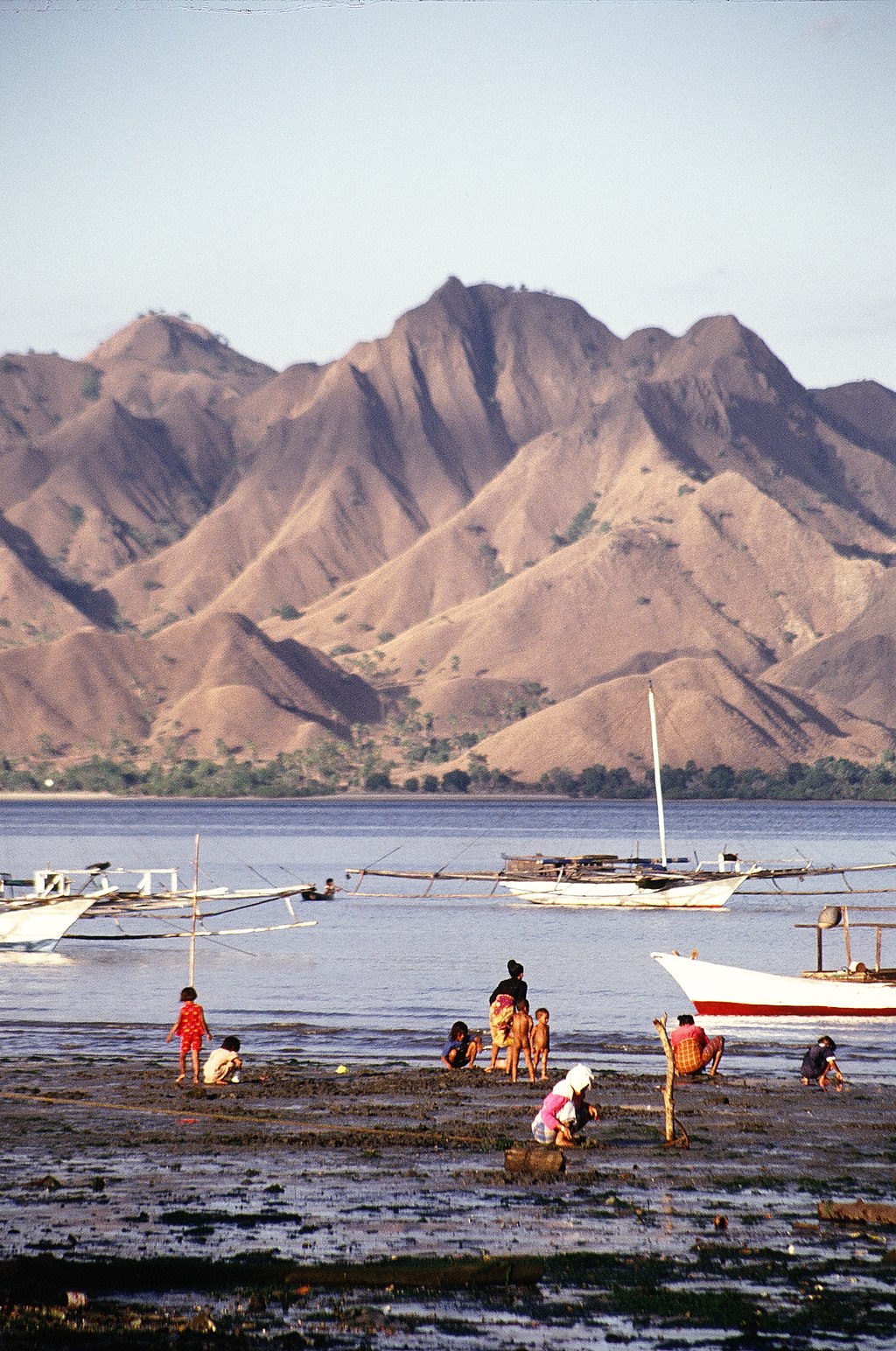
One of four villages located in Komodo National Park. Actually it’s prohibited to built a residential area inside the National Park; however since these villages inhabited since early 1950, it’s not easy to relocate them. Danadi Sutjianto, CC BY-SA 4.0, via Wikimedia Commons
Komodo National Park Village, also known as Komodo Kampung, is a small village located on the northwestern coast of Komodo Island, the largest island in Komodo National Park, Indonesia. The village is situated in a sheltered bay with stunning views of the surrounding islands and the turquoise waters of the Komodo Strait.
Yes, you can visit some villages around the Komodo National Park. These villages often organize tours or welcome tourists who are exploring the area. To visit, you can arrange a tour through local guides or tour operators based in Labuan Bajo or nearby towns. They offer day trips or excursions that include visits to villages within the park.
As for prices, they can vary based on the specific tour, services included, and the village you intend to visit. It’s best to inquire with local tour agencies or guides for details on pricing and what each tour entails.
Within the vicinity of Komodo National Park, some villages are frequently visited by tourists. Here are a few:
- Kampung Komodo: A village on Komodo Island itself, inhabited by locals and known for its proximity to the Komodo dragons.
- Kampung Rinca: Located on Rinca Island, another spot to observe Komodo dragons and experience local village life.
- Kampung Melo: Found on Flores Island, this village offers cultural experiences and traditional weaving demonstrations.
- Kampung Baru: Situated near Labuan Bajo, this village provides insights into local life and craft-making.
- Kampung Komodo Kecil: Located on Komodo Kecil Island, a smaller island within the park, Kampung Komodo Kecil offers a secluded and authentic experience. It’s known for its traditional fishing practices and close connection to the natural environment.
These villages provide opportunities to experience the culture, traditions, and daily life of the people living in and around the Komodo National Park area.
3. Scuba dive to admire the underwater flora and fauna
Read also: Best Dive Spots in Bali: A Guide to the Best Underwater Wonders

Marine turtle in Komodo National Park. Nhobgood Nick Hobgood, CC BY-SA 3.0, via Wikimedia Commons
Here is the list of the best dive sites on the island:
Manta Alley: this is the best place to observe the famous manta rays. This relatively shallow site, between 10 to 20 meters (30.80 – 60.60 ft), allows you to maximize the time spent underwater and make the most of the aquatic spectacle.
- Batu Balong: its coral gardens are teeming with fish. Strong currents and steep drop-offs attract big fish like Napoleon wrasse and sharks at greater depths. Photographers will be able to capture unforgettable photos.
- Golden Passage: This is a popular drift dive site close to Gili Lawa Darat. You can see corals, reef sharks, and sometimes even dolphins and manta rays.
- Manta Point: this site offers the chance to dive with manta rays that come to feed in the current. This drift dive with strong current allows you to see white tip reef sharks, nasons and small squills.
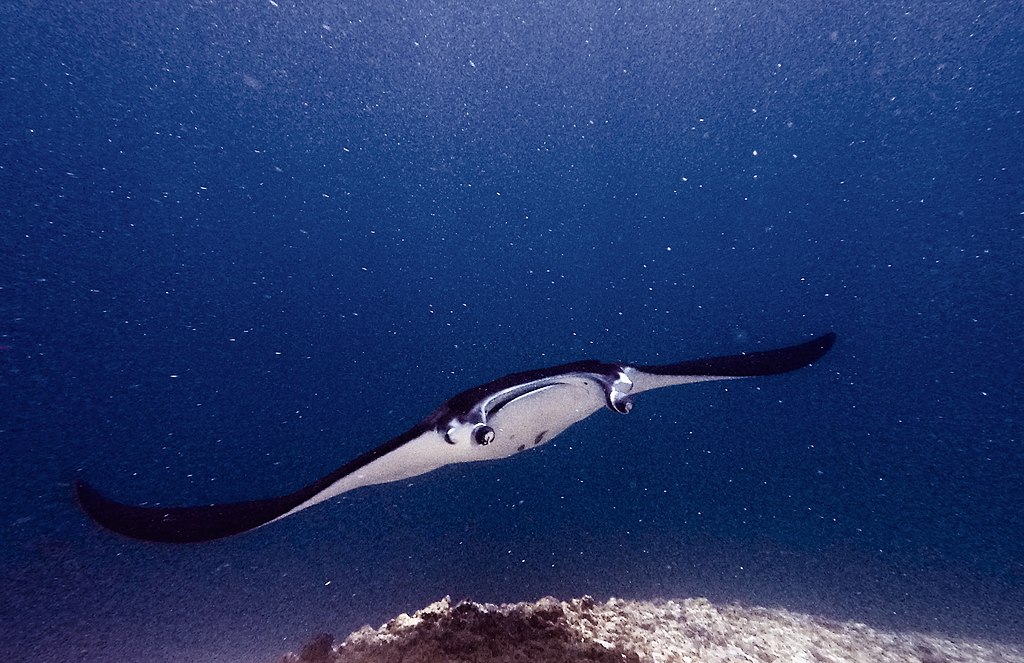
A flying manta ray is filtering plankton by swimming against the current in Manta Point, Komodo National Park. Siharaditia, CC BY-SA 4.0, via Wikimedia Commons
BATU BOLONG, ON THE SOUTHWEST COAST OF NUSA PENIDA
Explore the southwest coast of Nusa Penida, known for its captivating dive sites. One standout location is Batu Bolong, an iconic spot that promises a rich underwater experience. This legendary site, which even inspired the Warnakali restaurant logo, boasts abundant marine life, mesmerizing aquatic displays, and encounters with sharks, rays, and the elusive mola mola. Our divers’ stories of this unforgettable dive will leave a lasting impression on your memory.
Situated off the southern coast of Nusa Penida, Batu Bolong features a striking arch that’s often captured in photographs. To ensure a safe dive, it’s best explored during a rising tide with low swell conditions, keeping in mind the potential for strong currents and waves. The pinnacle offers glimpses of various pelagic species along the steep walls, while the walls themselves showcase a vibrant array of macro-life thriving among the stunning corals.
4. Go to Padar island
Padar Island is one of several islands scattered in the Komodo National Park area, this island has a shape with several bays, white and reddish beaches and several beautiful hilltops.
Padar Island is covered with savannah hills. Steep volcanic mountains covered with bushes and meadows lead to deep bays with beaches of different colors, popular with divers. Its three main turquoise bays have stunning beaches: one is white, another is charcoal black, and the other is soft pink. The black beach has a volcanic origin, while the pink consists of red coral mixed with white sand.
 Padar Island is the third largest island in the Komodo National Park area, after Komodo Island and Rinca Island. YUS JULIADI, CC BY-SA 4.0, via Wikimedia Commons
Padar Island is the third largest island in the Komodo National Park area, after Komodo Island and Rinca Island. YUS JULIADI, CC BY-SA 4.0, via Wikimedia Commons

One of beach in Padar Island, located in Komodo National Park. Find your joys and calm feel, just by looking the nature here. Triayusept, CC BY-SA 4.0, via Wikimedia Commons
The best time is April-June and also the dry season; September-November. July and August are very crowded and December to March is too rainy. Padar is about 30 km (20 ml) from Labuan Bajo, a fishing town on the westernmost part of Flores. Take a 30 minute hike to the top of Padar to see the whole island.
With its diverse landscapes and mesmerizing vistas, Padar Island stands as a testament to the natural wonders that Indonesia has to offer.

The view of Padar Island from the western coast. LukeTriton, CC BY-SA 4.0, via Wikimedia Commons
To reach Padar Island, you can follow these steps:
Many tour operators in Labuan Bajo offer guided tours to Padar Island as part of a package that includes other popular spots like Komodo Island and Rinca Island. This is a convenient way to explore the area.
If you prefer a more personalized experience, consider chartering a private boat. This option provides flexibility in terms of timing and allows you to customize your itinerary. Once you arrive at Padar Island, be prepared for a short but moderately challenging hike to the viewpoint. The trail is well-marked, but it’s a good idea to wear comfortable clothing, sturdy shoes, and bring some water.
5. Visit Rinca island
If you are eager to meet the famous Komodo dragons during a hike, then do not hesitate to discover the island of Rinca. Indeed, this island is the closest to Labuan Bajo (on the western coast of the island of Flores), the starting point for excursions to Komodo National Park.
Unlike Komodo Island, Rinca Island is smaller with an area of approximately 196.25 km² (643 864.82 ft²). The chance of seeing giant monitor lizards in their natural environment is then greatly increased.

Panorama of Rinca Island. This island is located in the Komodo National Park, East Nusa Tenggara. Pambudiyoga, CC BY-SA 4.0, via Wikimedia Commons
Rinca Island is the closest to Labuan Bajo and surprisingly the least visited. A 2-night boat cruise in the Komodos archipelago not only allows you to meet the dragons, but also to discover the richness of the underwater fauna and flora of the Komodos archipelago.
It is worth remembering that komodos are wild animals and that they can present a certain danger if their tranquility is not respected. It is mandatory to keep your distance from the animal and to follow all the recommendations of your guide and the local ranger who will accompany you on the excursion.
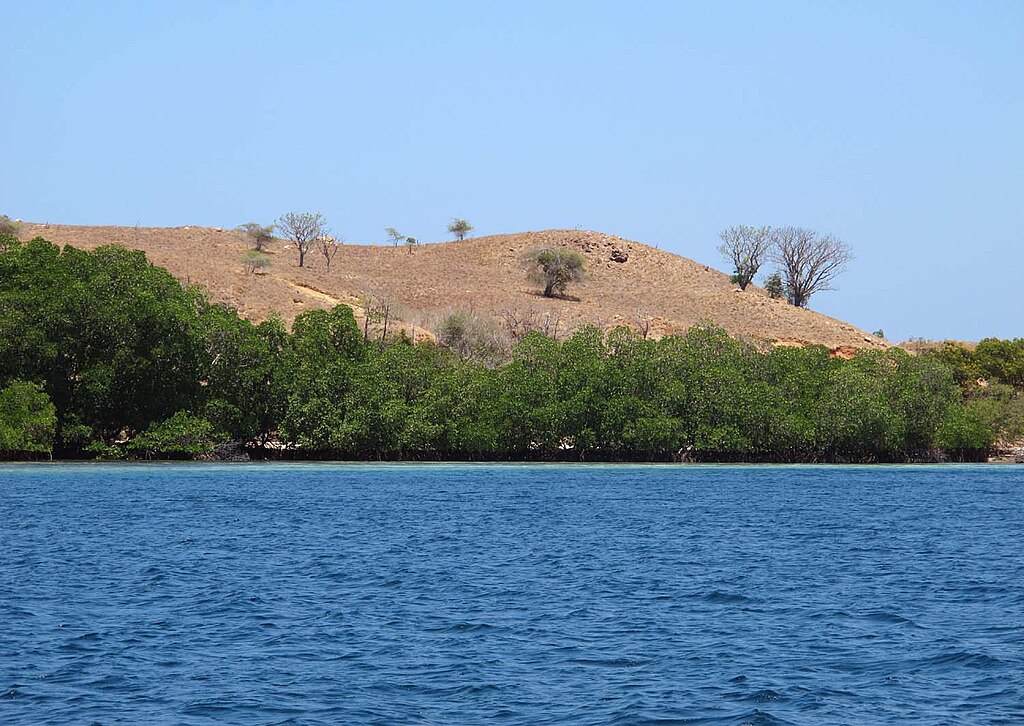
Rinca shore. Amelia Samulo, CC BY-SA 3.0, via Wikimedia Commons
6. Stop at Kanawa island
Kanawa Island is also known as the gateway to Komodo Island because all ships heading to Komodo Island will definitely pass through this island.
The island which has an area of about 32 hectares (80 acres) is approximately 15 km (9 miles) from Labuan Bajo (the capital of West Manggarai).
You can spend a day relaxing on the hammock, camping, playing beach volleyball, getting a massage on the beach, trekking to the hills, snorkeling, diving, or enjoying the view of the sky at night.
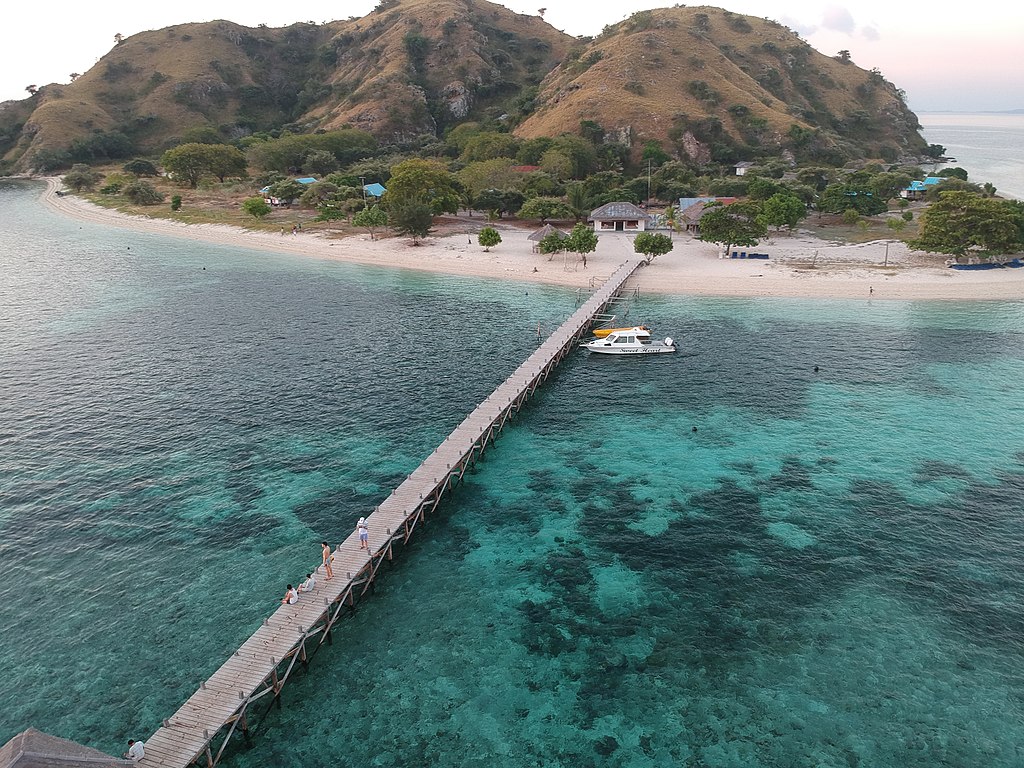
Kanawa Island from above (in the Komodo National Park). SunDawn, CC BY-SA 4.0, via Wikimedia Commons

Kanawa Island, Komodo National Park. Jordy Meow, CC BY 3.0, via Wikimedia Commons
7. Visit Pink beach (Pantai Merah Muda)
Is Pink Beach really pink?
Let’s be clear: if you’re expecting a flashy pink beach, you’re going to be disappointed! On the other hand, yes the sand of this page has a rather pink color, due to the presence of large fields of multicolored corals which are located offshore.
Apart from the giant lizards that give the park its name, Komodo National Park is also well known for its beautiful, undeveloped beaches. One of the most unique is Pink Beach (Pantai Merah), named for the pink sand that gets its color from weathered chunks of red coral from the nearby reef.

Pink beach is one of the main tourist attractions at Komodo island, one of the big island at Komodo National Park. Devagonal, CC BY-SA 4.0, via Wikimedia Commons
Clear, calm waters make the beach an excellent site for snorkeling, especially since the coral reefs just below the surface are home to hundreds of species of marine plants and animals. Located about 15 minutes by boat from Loh Liang pier, Pink Beach is a great place to relax in the sun or cool off in the water after a day of trekking in the national park.

Pink beach Komodo Island. Christopher L Edison, CC BY-SA 4.0, via Wikimedia Commons
There are 2 pink beaches:
The pink beach on Padar definitely has more colorful sand, but the Komodo pink beach has a nicer background for photos, with lots of steep hills and trees.
8. Go to Kelor Island
Kelor Island is located near Komodo Island, within Komodo National Park in Indonesia. It is a small, uninhabited island known for its pristine beaches, lush vegetation, and stunning views of the surrounding archipelago. Kelor Island is a popular destination for snorkeling, diving, and hiking, offering visitors a tranquil escape from the more tourist-centered Komodo Island.
The island offers a tranquil escape and serves as a popular spot for day trips or island-hopping adventures for visitors exploring the Komodo region.
You have the flexibility to visit Kelor Island either before or after exploring Komodo Island. Both islands offer unique experiences within the Komodo National Park, and scheduling your visit to Kelor Island before or after Komodo Island allows you to tailor your adventure based on preferences or available time.
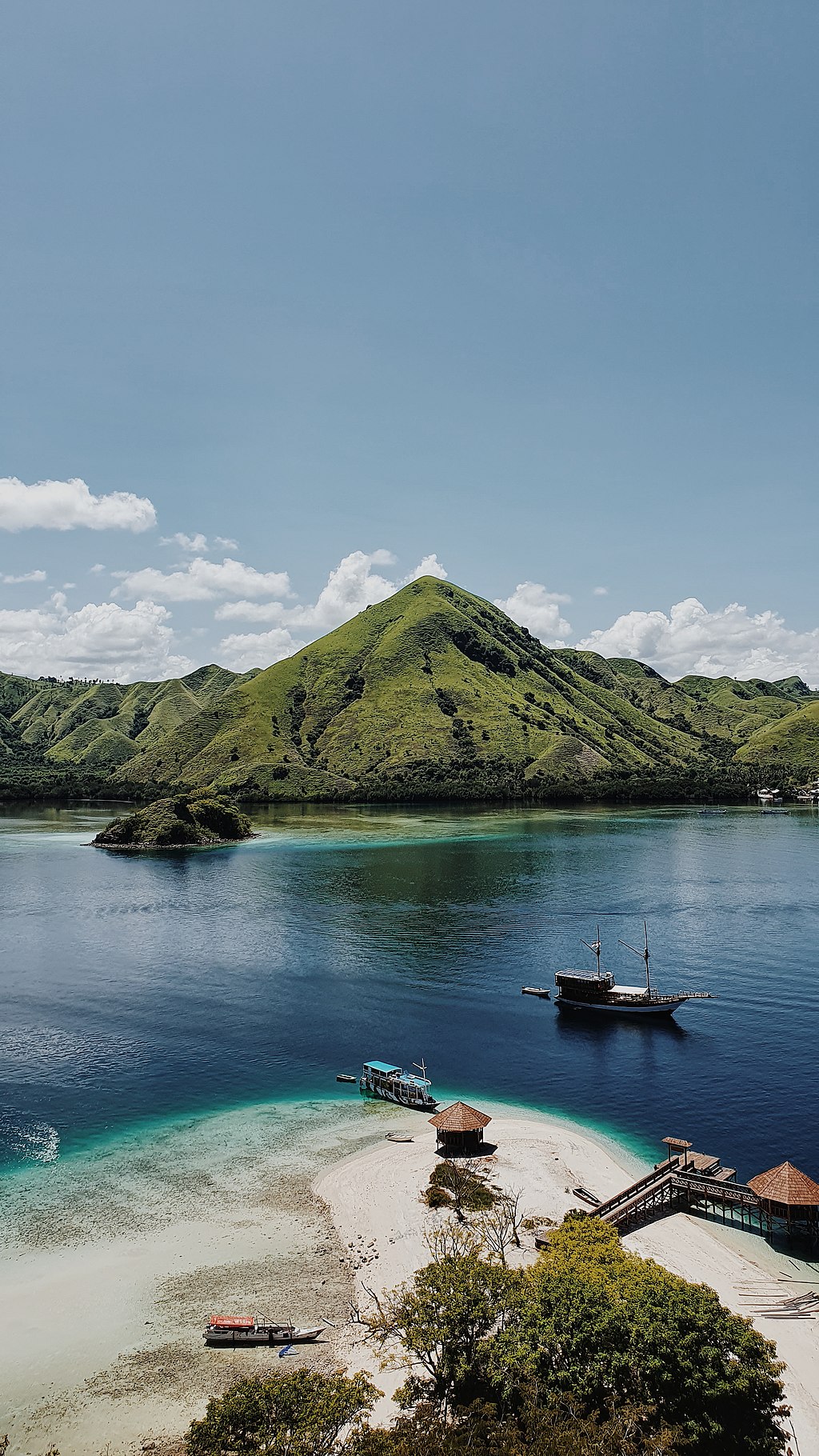
Kelor Island stands as the initial stop when sailing across the Flores Sea. This compact yet trek-worthy island offers the finest views within the Komodo National Park. Its crystal-clear waters serve as a calming retreat for the soul after a refreshing hillside climb. Jonathangarryh, CC BY-SA 4.0, via Wikimedia Commons
A brief 15-minute hike
A brief 15-minute hike unveils a stunning panoramic view from the top of Kelor Island, offering vistas of Flores, Rinca Island, and the surrounding smaller islands within the Komodo National Park. The ascent, though short, is steep and lacks stairs, so take caution to prevent slipping.
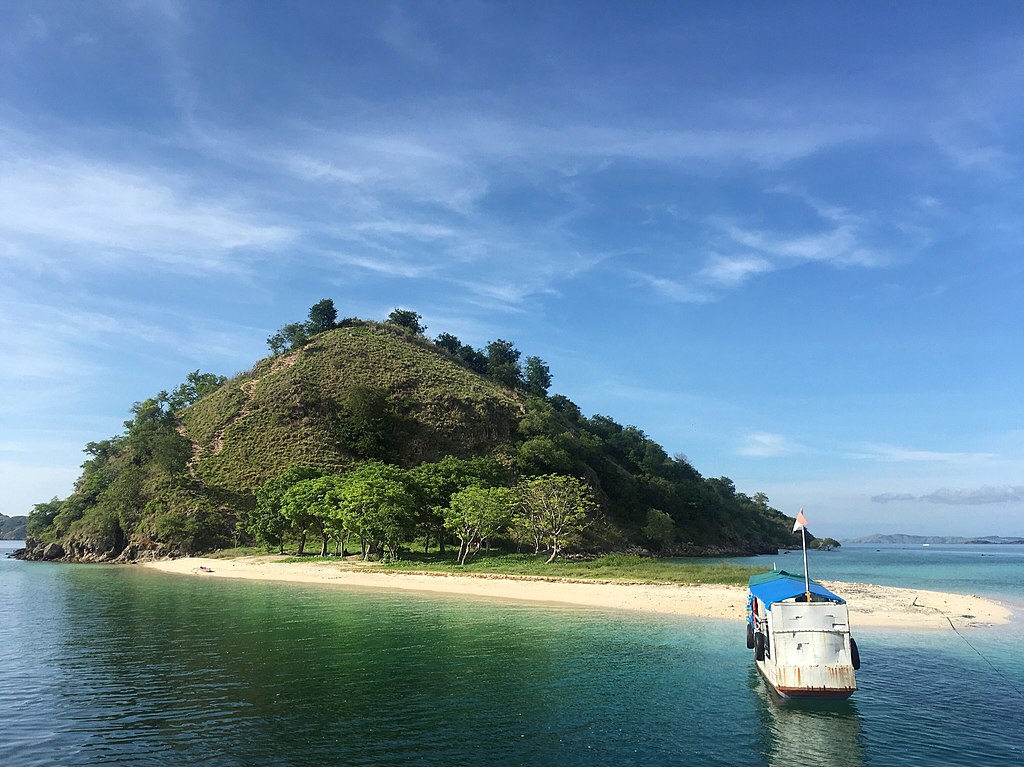
Kelor Island rests in the Flores Sea, offering a quick 15-minute hike for visitors. Bungachiara, CC BY-SA 4.0, via Wikimedia Commons
The captivating reward awaits at the summit, making this minor exertion entirely worthwhile. Kelor Island provides a perfect opportunity for photography enthusiasts to capture breathtaking scenery in all its glory.

There are several trails on Kelor Island that lead to stunning viewpoints of the surrounding islands and the turquoise waters of the Komodo Strait. You can relax on the beach perfect for relaxing and soaking up the sun. AgRidwan, CC BY-SA 4.0, via Wikimedia Commons
Facts
Komodo National Park is located in Indonesia, in the Lesser Sunda Islands, bordering the provinces of the West Lesser Sunda Islands and the (East Lesser Sunda Islands).
The national park includes the three large islands of Komodo, Rinca and Padar, as well as many other smaller ones. The total area of the park is 1,817 km² (701 miles²) with a land area of 603 km² (375 miles²).
The park also has many lesser islands (island group); Such as Gili Motang Island and Nusa Kode Island.
The national park was established in 1980, with the aim of protecting the Komodo dragon (Varanus komodoensis) and cetaceans. The objective was later extended to protection of the flora and fauna of the region, including in the maritime areas.
The islands of the national park are of volcanic origin and 4,000 people live there. In 1991, the park was included in the list of World Heritage and Biosphere Reserve by UNESCO since 1977.
Health and security
If you plan to go on a trip to Komodo Island, we advise you to invest in a good travel insurance that also covers scuba diving. You never know what can happen and good insurance can get you out of tough situations. I recommend this travel insurance because they offer worldwide coverage and cover many risky sports like scuba diving. Read also: Health and Safety in Indonesia
KOMODO DRAGONS & PINK BEACHES – KOMODO ISLAND BOAT TOUR
SAILING AT KOMODO ISLAND
Some Ideas for Exploring Komodo: From Dragons to Aquatic Wonders – Private Tours from Labuan Bajo
Embark on a remarkable voyage that unveils the mystique of Komodo’s ancient reptiles and the mesmerizing beauty of its surrounding islands with our exclusive private tours from Labuan Bajo.
Komodo Dragons & Islands Day Tour: Unveiling the Mystique of the Ancient Reptiles
Embark on an extraordinary journey to witness the awe-inspiring Komodo Dragons, the largest living lizard species, in their natural habitat. This day tour unveils the captivating beauty of the Komodo Islands, where you’ll encounter these prehistoric creatures up close. Discover their intriguing behaviors and learn about their conservation while exploring the stunning landscapes of the islands.
Private Day Tour by Speedboat: Exploring the Gems of Labuan Bajo
Experience the epitome of luxury and personalization with a private day tour by speedboat. Sail through the pristine waters of Labuan Bajo and indulge in the breathtaking beauty of the surrounding islands. Immerse yourself in the crystal-clear waters as you swim and snorkel, marvel at vibrant marine life, and savor a sumptuous lunch amidst nature’s serenity.
Labuan Bajo: Swim and Snorkel Komodo Island Trip with Lunch
Dive into an aquatic paradise with this immersive day trip from Labuan Bajo. Discover the enchanting underwater world as you snorkel amidst the coral gardens and colorful marine life around Komodo Island. After your underwater adventure, relish a delectable lunch on board, soaking in the mesmerizing views that surround you.
From Labuan Bajo: Private Full-Day Komodo National Park Tour
Embark on a full-day private tour to the iconic Komodo National Park from Labuan Bajo. Traverse through the picturesque landscapes, marvel at the rugged coastlines, and set foot on the renowned Komodo Island. Witness the majesty of the Komodo Dragons and explore the ecological diversity that this UNESCO World Heritage site offers.
Komodo Island: Private 3-Day Tour with Boat & Hotel Stay
Indulge in an immersive 3-day private tour that encompasses the essence of Komodo Island’s allure. With a perfect blend of adventure and relaxation, explore the island’s breathtaking beauty, encounter its iconic reptiles, and bask in the tranquility of the surroundings. This tour provides an unforgettable experience, complete with comfortable accommodations and a chance to fully immerse yourself in the marvels of Komodo Island.
Must See Places in Indonesia | A Guide to the Country’s Best Attractions to Explore and Discover
Sources: CleverlySmart, PinterPandai, UNESCO, Wonderful Indonesia, Divezone
Main photo credit: Irdan nofriza nasution (CC BY-SA 4.0) via Wikimedia Commons
Main photo description: Padar, also known as Pada, is a small island located between Komodo and Rinca islands within Komodo archipelago, administrated under the West Manggarai Regency, East Nusa Tenggara, Indonesia. It is the third largest island part of Komodo National Park.
One of the natural charms of Indonesia in the province of East Nusa Tenggara is Padar Island, an exotic island with its natural marine beauty that offers a million natural charms.
🚫 What You Can’t Do in Komodo National Park:
-
Ignore ranger instructions or stray off designated trails.
-
Approach or feed wildlife—this includes both land and sea animals.
-
Dive without a licensed guide or explore outside operating hours.
-
Litter, play loud music, or use drones without permission.
-
Anchor boats in shallow waters or speed near dive/snorkeling spots.
-
Bring pets, weapons, fireworks, or dangerous tools.
-
Camp, light fires, or smoke in restricted areas.
-
Collect natural resources or wildlife (alive or dead)—this is strictly illegal.
-
Host beach dinners, barbecues, or cookouts on the coast or inland.
-
Disrupt others, damage facilities, or cause any kind of public disturbance.
Everyone—tourists, guides, operators, and officials—is expected to respect these rules and help enforce them in their group.
Ready to book your villa in the heart of lively Seminyak, Bali?

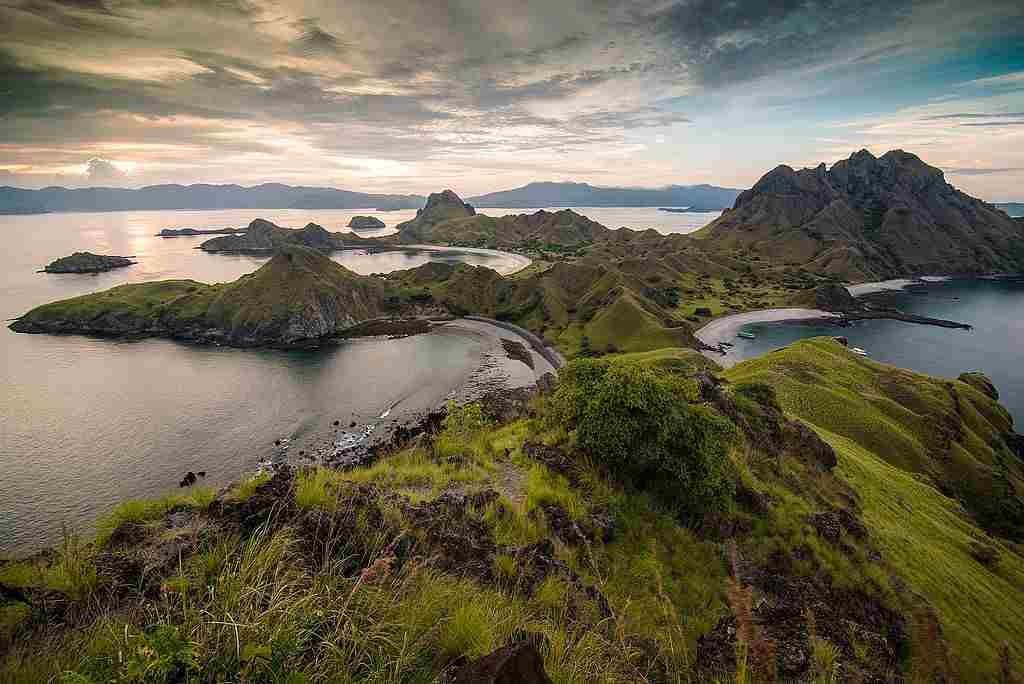
Hi, what are the top three things to do on Komodo Island? And why? Thanks in advance!
Hi Sophie,
In Komodo Island, there are several amazing things to do, but if I had to pick the top three, they would be:
1. Komodo National Park tour: see the iconic Komodo dragons in their natural habitat.
2. Snorkeling and diving: explore vibrant coral reefs and diverse marine life.
3. Hiking and trekking: discover stunning landscapes and scenic viewpoints.
These activities offer unforgettable experiences in Komodo Island’s natural beauty and wildlife.
Thoroughly enjoyed reading the post! Your passion for these topics is evident throughout, providing me with valuable insights that I hadn’t considered before, from Bali to Komodo island!
Thank you for your kind words! We’re thrilled that you enjoyed the post and found it insightful. Bali to Komodo Island is truly a journey worth experiencing. Stay tuned for more exciting content!